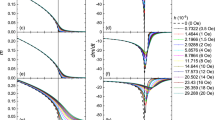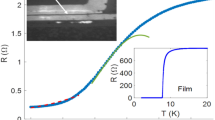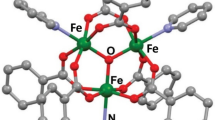Abstract
In two recent papers1 I have shown that there are two effects of a magnetic field on the electrical resistance of ferromagnetic wires. At temperatures appreciably below the Curie-point (C-P.) there is an increase + ΔR of the resistance by magnetisation which attains a saturation value exactly at the saturation of the magnetisation. The relation between the magnetisation I and the change of the resistance is + ΔR = c(I2 - I20), where I0 is a critical value of the magnetisation process; for example, in crystals the component of the spontaneous magnetisation in the direction of the field. So far as the limit I0 of the magnetisation, there is practically no change of resistance. The greater part of the resistance increase takes place in the region approaching saturation.
This is a preview of subscription content, access via your institution
Access options
Subscribe to this journal
Receive 51 print issues and online access
$199.00 per year
only $3.90 per issue
Buy this article
- Purchase on Springer Link
- Instant access to full article PDF
Prices may be subject to local taxes which are calculated during checkout
Similar content being viewed by others
References
W. Gerlach u. K. Schneiderhan, Ann. d. Phys., 6 (V), 772; 1930. W. Gerlach, Ann. d. Phys., 8 (V), 649; 1931.
H. H. Potter, NATURE, April 11, 1931, p. 555.
Author information
Authors and Affiliations
Rights and permissions
About this article
Cite this article
GERLACH, W., ENGLERT, E. A New Relation between Electrical Resistance and Energy of Magnetisation. Nature 128, 151–152 (1931). https://doi.org/10.1038/128151a0
Issue Date:
DOI: https://doi.org/10.1038/128151a0
This article is cited by
-
Magnetism and magnetoresistance in the critical region of a dilute ferromagnet
Scientific Reports (2021)
-
Fortschritte in der Physiologie der Blutgerinnung
Ergebnisse der Physiologie Biologischen Chemie und Experimentellen Pharmakologie (1940)
Comments
By submitting a comment you agree to abide by our Terms and Community Guidelines. If you find something abusive or that does not comply with our terms or guidelines please flag it as inappropriate.



